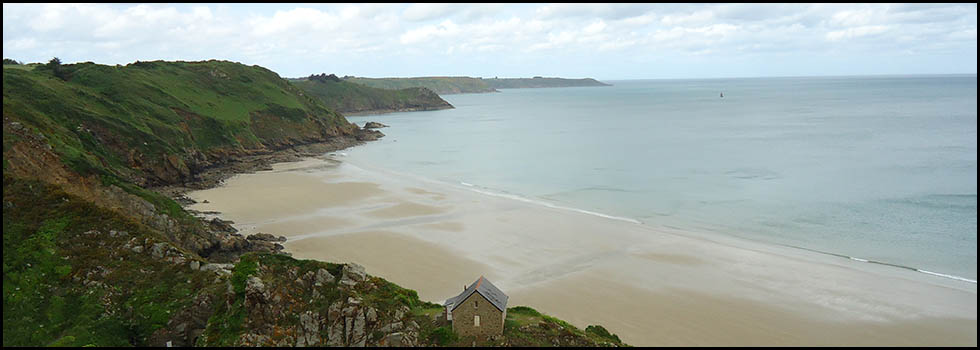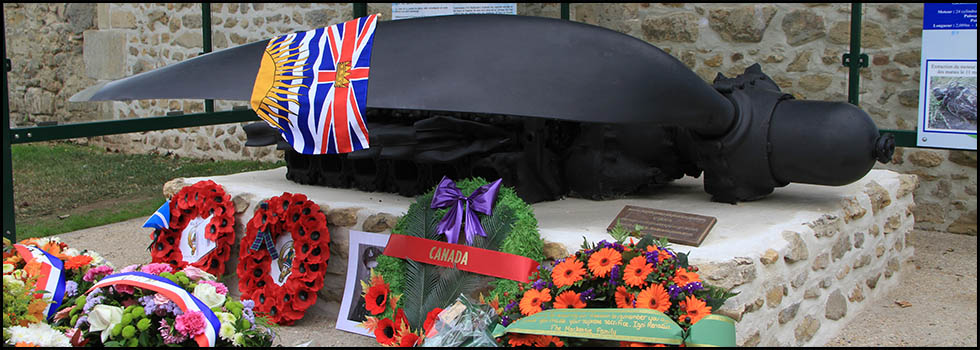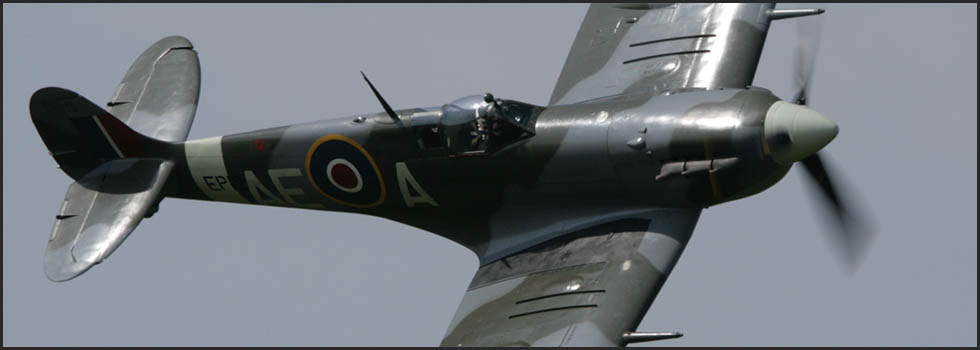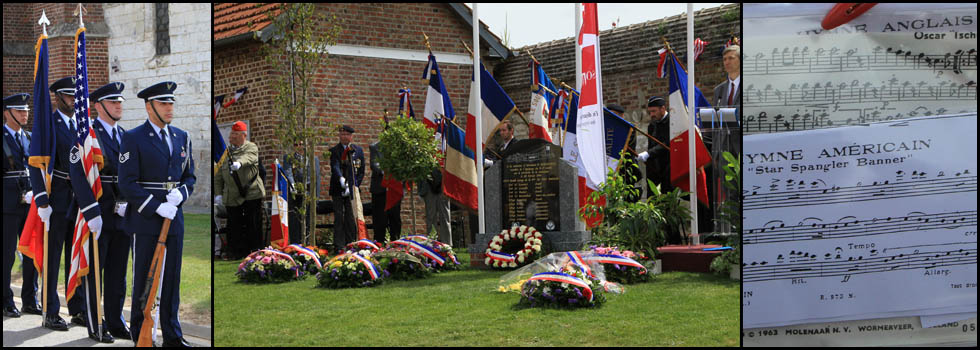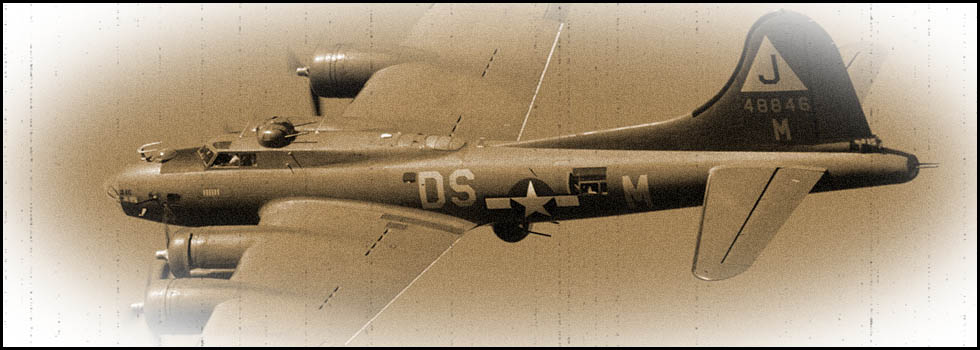Night of 1st to 2nd May 1944
Short Stirling Mk III EF259
HA-G
218 "Gold Coast" Squadron
Royal Air Force
Crèvecœur-le-Grand (Oise)
Copyright © 2025 - Association des Sauveteurs d'Aviateurs Alliés- All rights reserved -
En français ![]()
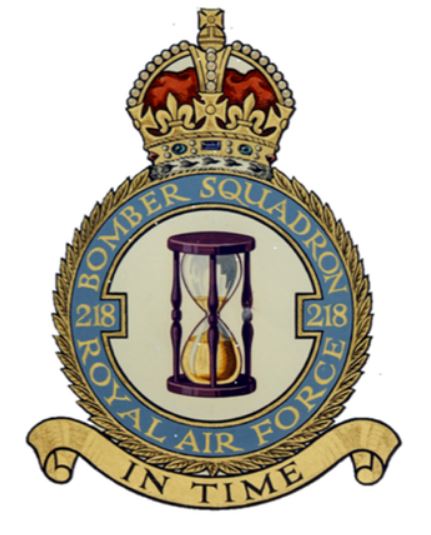
Mission: Chambly–Moulin-Neuf railway facilities (Oise).
During the night of 1–2 May 1944, Bomber Command set its sights on destroying the Chambly–Moulin-Neuf railway facilities, the most important depot and repair facility in the northern network.
120 bombers (96 Lancasters, 16 Stirlings and 8 Mosquitoes) took part in this raid.
One hundred and twenty bombers (96 Lancasters, 16 Stirlings and 8 Mosquitoes) took part in the raid.
The 16 Stirlings deployed belonged to RAF 218 Squadron, led by Squadron Leader John Overton. They took off at around 10 p.m. and headed south. The flight to the target took place under moonlight. Arriving after midnight as they approached Chambly, the Stirlings presented themselves, bomb bays open, in two successive waves. Preceded by the Pathfinders who marked the target on the ground with flares, 13 of them bombed the railway facilities from an altitude of between 13,000 and 14,000 ft. The bombing proved accurate. Nearly 65 tonnes of explosive and incendiary bombs dropped by the Stirlings of 218 Squadron were dumped on the depot, causing major damage to the workshops and railway tracks. Pockmarked with craters, the facilities were out of service for 10 days.
On the return flight, German night fighters appeared. A total of five bombers were shot down that night. A Lancaster from Squadron 7 crashed in flames at Presles (Val d'Oise). The other four aircraft were shot down over Oise department: a Lancaster from 514 Squadron near Reilly, another from 75 Squadron near Saint-Arnoult, a Stirling from 218 Squadron near Abancourt and the Stirling EF259 from Squadron 218 near Crèvecœur-le-Grand.
The crew of Stirling EF259 :
|
F/O Noel Stirling ELIOT |
Pilot |
28 |
RAAF |
|
F/O Edward George HAWKINS |
Flight Engineer |
RAF |
|
|
F/S Graham Arthur HASSETT |
Navigator |
23 |
RAF |
|
F/S Kevin John LYNCH |
Bomb aimer |
31 |
RAAF |
|
Sgt. Samuel Joseph CLAYTON |
Wireless operator |
24 |
RAF |
|
Sgt. Charles Fowler WEIR |
Mid-upper gunner |
20 |
RAF |
|
Sgt. Harold Frederick WILSON |
Gunner |
24 |
RAF |
|
Sgt. John Raymond GRANTHAM |
Rear gunner |
19 |
RAF |

Woolfox Lodge base, in front of a Stirling from Squadron 218.
From left to right: Charles Weir, Edward Hawkins, Samuel Clayton, Noel Eliot, Kevin Lynch, John Grantham and Graham Hassett.
Sgt. Harold Wilson is missing from this photo.
Having taken off from Woolfox Lodge base in Rutland County at around 10:15 p.m., F/O Noel S. Eliot at the controls of Stirling EF259 was on his 15th operational mission that night. Amidst the markers dropped by the Mosquitoes, the aircraft dropped its bomb load on the target. Attempting to return to England, it was attacked by two Luftwaffe Junkers-88. Sgt. John Grantham was killed at his rear gunner's position. The mid-upper gunner, Charles Weir, thought, without being certain, that he had shot down one of the two attackers. The left outer engine was on fire and the tail of the Stirling was almost detached. The pilot ordered the crew to evacuate the aircraft.
Only four airmen managed to bale out from the four-engine aircraft, which began a dizzying descent. It finally crashed at around 1 a.m. in the "Bois de la Pipe" near the hamlet of La Houssoye, close from the village of Crèvecœur-le-Grand.

Bois de la Pipe
That night, the Stirling was probably shot down by Hauptmann Fritz Söthe* of 4./NJG4, who claimed to have shot down a four-engine aircraft in the area at 00:55.
* Hauptmann Fritz Söthe was killed in action over Germany in a Junkers-88 during the night of 28 to 29 September 1944. He had a total of 18 victories.
The bodies of F/O Edward G. Hawkins, F/S Graham A. Hassett, Sgt. Samuel J. Clayton and Sgt. John R. Grantham were found among the wreckage of the aircraft. They now lie in the Commonwealth military cemetery in Poix-de-Picardie (Somme).
The four airmen who escaped death were rescued by the local population. Three of them (Eliot, Weir and Lynch) were taken in by the Alsace escape network run by Gilbert Thibault.
At around 00:45, F/O Noel Eliot landed in the Froissy area and found himself isolated. He immediately removed his parachute harness and Mae-West life jacket and hid them in a hedge at the edge of a wood.
He began walking southeast through woods and fields until 6 o'clock, then hid in a wood for the rest of the day. At nightfall, he resumed his journey and arrived near Thury-sous-Clermont around noon. During the afternoon, he kept watch for any German soldiers in the village.
Around 7 p.m., he approached farmers Jean Berthomier and his wife Alfrédie, who took him to their home in the hamlet of Fillerval. Noel Eliot was fed and hidden in a barn where a room had been set up upstairs.
The Berthomiers informed him that they had contacted someone (Noel Eliot thought it was the postmaster) and that someone would come to pick him up on 5 May. On that date, a man arrived by car and took him to Louis Marin, owner of the Rochy-Condé mill.
At his hosts' house, he was able to enjoy a hot bath and a few glasses of cognac. He stayed there for the night.
On the morning of 6 May, he was taken to the Therdonne mill. He stayed there for a few hours and was given food. An important member of the Resistance, probably Gilbert Thibault, visited him and checked his identification tags, declaring that he was now being taken care of by an organisation (the Alsace escape network). He also asked for details about the crew members and inspected his photographs.
At 10 p.m., he was taken by the owner's son to Maurice and Marguerite Defrocourt's house on Rue Adolphe Carpentier in Therdonne.
F/O Noel Eliot stayed with the Defrocourt family for about twenty days, lodging in a small room in their house. Their 19-year-old son Albert took him out in the evenings. They often played dominoes along the garden hedge next to a square where the Germans often played ball. One day, the ball rolled to their feet. As a German was about to jump over the hedge, Albert just had time to kick it back.
Another day, the Defrocourts received a visit from a policeman. Frightened at the sight of the uniform, the airman jumped out of the window. Marguerite Defrocourt just had time to catch him and explain that there was no danger. The policeman had simply come to deliver bread and ration cards.
To avoid attracting attention, the airman was given civilian clothes. They weren't very stylish, and some were even too small or too big. Maurice Defrocourt had to lend him one of his jackets.
During his stay, Henri Maigret, Gilbert Thibault's deputy, came to question him and take his photograph. He returned a few days later to give him false papers in the name of Albert Favro, which would soon enable him to continue his escape. To make them look less suspicious, Henri Maigret used to ‘age’ these false papers by rubbing them on the pavement.
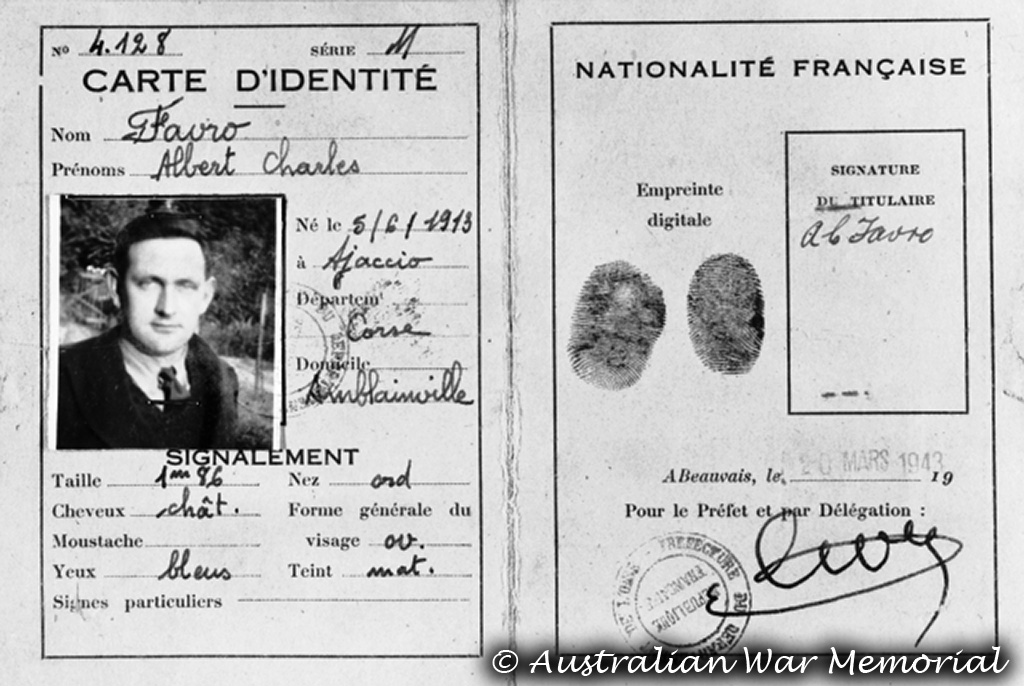
On the morning of 26 May, F/O Noel Eliot was taken in a vehicle driven by Gilbert Thibault, where American airmen were already waiting. After 15 minutes, they were stopped by two armed German soldiers at the side of the road. Unperturbed, Gilbert Thibault took control of the situation. He spoke to the Germans while the airmen were scared to death. To their great relief, the German soldiers let them go. They reached Chaumont-en-Vexin station. Henri Maigret was there with other escapees who had spent the night in a Ponts-et-Chaussées building near the station. Noel Eliot then found two of his crewmates: Sgt. Charles Weir and F/S. Kevin Lynch.
Sgt. Charles F. Weir landed in trees near the hamlet of La Bordé, close to Crèvecœur-le-Grand. It took him about an hour to free himself from his parachute, which had become entangled in the branches. He finally managed to gather up his parachute and hid it, along with his harness and Mae-West, in a bush. Moving away from his landing site, he found an open, partially burnt parachute in a field. Heading south, he arrived at Verderel-lès-Sauqueuse at around 6 a.m., where he hid in a barn until 10:30 a.m. He then saw a man and asked him for help, but the man did not respond. Shortly afterwards, a 20-year-old boy named René Capron came out of a house and invited him inside. He was given civilian clothes and food. In the evening, he was taken to another house belonging to his grandfather, Louis Planchon, aged 77.
On 6 May, Louis Planchon took him with a group of resistance fighters to a field where a plane was supposed to land. A patrol of two German soldiers fired at them, but they managed to escape unharmed. That day, a member of the Resistance came to meet him. He was photographed, and the man told him that his pilot, Eliot, and his bomb aimer, Lynch, were also being sheltered in the area. He also told him that two bodies had been found among the wreckage of the aircraft and that a radio operator's badge had been discovered on one of the uniforms.
On 11 May, Henri Maigret gave him his false identity card. Because of his blond hair, Charles Weir took the name Jean Leblond.
On the morning of 24 May, Henri Maigret and his boss, Gilbert Thibault, came to tell him he was leaving soon, then left. In the afternoon, Gilbert Thibault returned and took Sgt. Charles Weir away, picking up F/Sgt. Kevin Lynch and a Canadian airman, F/Sgt. Robert Hortie, on the way. The airmen spent the night in Auneuil, at Gilbert Thibault's house.
They spent the following night in a Ponts et Chaussées equipment depot near the Chaumont-en-Vexin railway station. Timber beams laid across the rafters formed a sort of attic and served as a refuge for the airmen. That night, the Germans had the bad idea of conducting manoeuvres near the building. The airmen were unable to sleep a wink.
On the morning of 26 May, Henri Maigret picked up the exhausted airmen, who followed him at a distance to the station. There they were reunited with Noel Eliot, their pilot, who was accompanied by American airmen.
After landing, F/S Kevin Lynch discarded his parachute and headed south. His first contact with a Frenchman turned out to be Pierre Crochu, a grocer from Saint-Martin-le-Nœud, to whom he declared himself to be an Australian airman and asked for bread.
Pierre Crochu entrusted him to Robert Hardy, a 20-year-old student teacher who lived in the hamlet of Sénéfontaine. Kevin Lynch stayed there for about three weeks.
Henri Maigret, who came to question him and take his photograph, issued him with false papers with the name of Jean-Pierre Dupuis.
On 23 May, he was taken to Mrs Portebois's house at the school in Fleury, where he spent the night.
On 24 May, he was taken to Chaumont-en-Vexin in Gilbert Thibault's car, where he was reunited with Sgt. Charles Weir and then, on the 26th, with F/O Noel Eliot.
Sgt. Harold F. Wilson parachuted near the village of Viefvillers, about 5 kilometres east of Crèvecœur-le-Grand. He buried his parachute, harness and Mae-west in a field and then hid. He opened his escape kit and ate some of its contents. Later, he made his way to a farm, entered through a window, and frightened the owners. Once reassured, Paul Lurois and his family welcomed him with open arms, fed him, and gave him a bed in the attic.

Sgt. Harold F. Wilson
The next day, the Germans invaded the village in search of the airman. All the houses were searched except for Paul Lurois's, which was housing German officers.
Four days later, Harold Wilson was brought before a member of the Resistance living in Crèvecœur-le-Grand, who tried in vain to repatriate him to England via the Shelburn escape network from Brittany. Later, he tried again to help him escape with a group of seven airmen staying in the area. Due to the recent Allied landings in Normandy, the plan was abandoned.
Harold Wilson stayed with the Lurois family in Viefvillers until 14 August. As the Allied troops advanced, the Germans began to retreat. He was sent to Coulemelle (Somme), where he stayed with Jacques Hébert until 1 September, when he was brought back to Viefvillers. The region had then been liberated. After contacting Allied officers, he left for Amiens, from where he flew to England on 16 September.

Towns and villages where the four escaped airmen were housed.
On 26 May, departing from Chaumont-en-Vexin station, Henri Maigret single-handedly transported the airmen to Paris. F/O Noel Eliot, F/Sgt. Kevin Lynch and Sgt. Charles Weir took a train and got off at a station not far from Saint-Ouen, where it had been agreed that a lorry would be waiting for them. When they arrived, Yvonne Deplanche got out of the cab of the lorry. Henri Maigret and the airmen climbed into the back, where shovels and pickaxes had been placed to simulate a team of road workers going to work. Sitting on the floor, they were all frozen with cold. Slowly, the lorry reached Argenteuil, where it parked near the station.
Lynch, Eliot and Weir were taken to the Argenteuil hospice, which had been emptied of its residents following the bombings. The airmen stayed there for four hours and were given a meal before taking a train back to Paris. From that moment on, Henri Maigret's escort mission was over.
After getting off at Saint-Lazare station, their new guide, Pierre Robert, took them to Rue Bellechasse in the 7th district, to the back room of Andrée Donjon's flower shop, where they met Philippe and Virginia d'Albert-Lake.
That same evening, Germaine Mélisson, alias ‘Anne’, took Noel Eliot and two American airmen to her flat on Rue de Montessuy, near the Eiffel Tower.
In preparation for the Normandy landings, the intensification of Allied bombing on transport routes made it very difficult and risky to transport the airmen to the Spanish border or Brittany. The decision was made to set up reception camps for the airmen in occupied France while they waited for the arrival of Allied troops. 152 airmen stayed there.
On 28 May, Germaine Mélisson took Eliot, Lynch and Weir and other airmen by metro to Austerlitz station and accompanied them to Châteaudun, where they arrived at around 2.30 p.m. Taking over from her, other guides took them to the Fréteval area, where they stayed for a fortnight. The day after their arrival, Lucien Boussa and Jean de Blommaert came to visit them.
On 11 June, Noel Eliot was taken to Villebout, where he stayed at Germain Fouchard's farm. Kevin Lynch and Charles Weir were sent to Mrs Guérineau's house in Morée.
A fortnight later, they joined one of the camps set up in the Fréteval forest.
On 14 August, they were liberated by American troops. The airmen were first taken to Le Mans and then to Laval, where they stayed for the night.
On 15 August, the airmen boarded a convoy of six lorries bound for Bayeux. On the way, one of them swerved on a bend and overturned. Kevin Lynch, after extricating himself from his burning bomber, landing safely and escaping without a scratch, was injured. He was repatriated to England a few days later and hospitalised.
On 18 August, Noel Eliot and Charles Weir were repatriated to England from Banville airfield (Calvados).
10 September 2022 - Ceremony in memory of the crew of Short Stirling EF259

